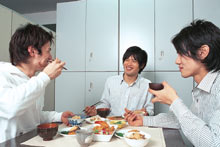| Web Japan > NIPPONIA No.36 > Special Feature* |
|
|
|
NIPPONIA No.36 March 15, 2006 |
|
Less is more
Western and Chinese chefs hone their skills and use their tools of the trade to create tastes that are quite different from the natural ingredients. In traditional Japan, however, the aim is to keep human intervention to the minimum, to serve food as close to its natural state as possible. Japanese traditional cuisine emphasizes the original taste of the ingredients, trying not to hide the real taste with some human artifice. The ideal in Japanese cooking is not to overdo it.
The ultimate “underdone” food is sashimi. The fresh fish arrives at the table raw, sliced into pieces that you dip in a mixture of soy sauce and wasabi. This is the best way to enjoy the taste of fish, and we can rank sashimi at the pinnacle of the Japanese culinary experience.
For food to be enjoyed in its close-to-natural state, it must be fresh. So before we judge whether a chef is talented or not, we examine the freshness of the ingredients. Japanese culinary enthusiasts are keen on food in season—savoring the season (shun) is experiencing the taste of freshness. This idea is at the heart of traditional Japanese cuisine.
Evolution in the kitchen
When Westernization began around the time of the Meiji Restoration (1868), the average Japanese was quite slight in build. To build a modern industrialized nation, members of the government and the educated elite thought that Japan needed a taller and more robust workforce and military. This they encouraged by promoting the addition of meat and dairy products to the traditional diet.
Except for sukiyaki and a couple of other dishes, traditional Japanese cuisine provided no guides on how to prepare and cook meat, so chefs turned to foreign recipes. Their main guide was Western cuisine. The Japan of the time was keen to modernize, using the West as a model. It was only in the mid-20th century that meat recipes were introduced from China and the Korean peninsula, even though, like Japan, rice was the staple food and chopsticks were used there.
Meat was a new ingredient requiring new and foreign recipes, and as this foreign cuisine became more common it took on a Japanese character of its own. The seasonings were changed to make the meat go well with rice, and the ingredients were cut up smaller to make them more manageable for chopsticks. The Japanese like the flavor that soy sauce gives to a meal, and they considered Worchester sauce as a kind of Western soy sauce, so they began using it with their Japanese-style Western food.
Today, home cooking in Japan shows so many foreign influences that some people call it cosmopolitan, although we might rather think of it as a new type of Japanese cuisine. The Japanese are said to be good at absorbing things from abroad while modifying them to their own taste. The same is true for cooking. Since the 1960s, Japanese rice consumption has continued to fall, and is now half what it was 40 years ago. This is not surprising, because rice now plays second fiddle to the side dishes. In the old days the home meal would be lots of rice, one side dish, a soup (probably miso), and some pickles. It was only during festivals and formal occasions that several side dishes were served to each person. But today, at suppertime each family member gets about three tasty side dishes. So it is natural that rice is no longer the only star of the show at the dinner table.
Economic growth has made it possible for the Japanese of today to enjoy as much food in an ordinary meal as their ancestors did during a festival. Each meal is now a festival of food, but without the gods of old.
|
|

